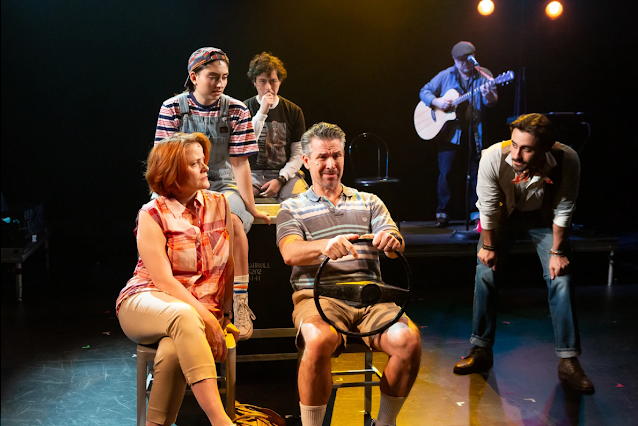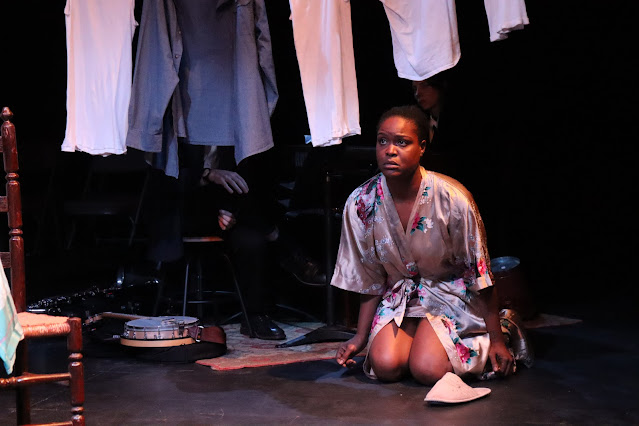Review: "The Greatest Hits Down Route 66" Takes a Trip Through the American 20th Century
The Greatest Hits Down Route 66
Written by Michael Aguirre
Musical arrangements by Grace Yukich and Jennifer C. Dauphinais
Directed by Sarah Norris
Presented by New Light Theater Project in association with Calliope Stage and NewYorkRep at 59E59 Theaters
59 E 59th St., Manhattan, NYC
January 13-February 18, 2024
 |
| L to R front: Erika Rolfsrud, Kristoffer Cusick, Joél Acosta. L to R rear: Kleo Mitrokostas, Martin Ortiz, Andy Evan Cohen. Photo by Hunter Canning |
Fittingly, the clan at the center of The Greatest Hits Down Route 66 both is and is not the archetypal American nuclear family. On the one hand, for example, the family is made up of a heterosexual couple with two kids, a minivan, and a father inflexibly devoted to the itinerary that he has created; but on the other, the kids' paternal grandfather, Miguel, crossed the border from his native Mexico, following Route 66 and settling in the United States permanently, and the family's ability to take a road trip vacation is shadowed by suggestions of economic insecurity, especially in contrast to the children's ostentatiously successful uncle Tim (Joél Acosta). Tim is brother to the family patriarch (Kristoffer Cusick), who goes by Wolf Man for reasons which, it turns out, are probably not what you would think. Wolf Man's (estranged) relationship to Miguel supplies an important motivation for the trip, as well as for questions of identity that Miguel's Mexicanness raises for his grandchildren. Wolf Man's wife (Erika Rolfsrud) is of Polish extraction, a heritage that Wolf Man points out she, unlike him, can take up or ignore as suits her (although one anecdote underscores how she, along with her husband, is nonetheless categorized by class). Their elder son (Martin Ortiz), Luke, is a teen deep in the midst of a rebellious phase of intellectual skepticism fueled by numerous AP courses, while his sensitive younger brother, Michael (Kleo Mitrokostas), referred to by the family as Wee One, identifies himself as the artistic one.
 |
| L to R: Erika Rolfsrud, Kleo Mitrokostas, Martin Ortiz, and Kristoffer Cusick. Photo by Hunter Canning |
There was less, or less successful, self-definition as a father, one part of the way in which the play presents us with complex characters, including Miguel, people whose imperfections are inextricable from their attempts to figure out who they are to themselves and to others. Those attempts evince a blending of invention and fact in their personal histories which parallels that in America's national histories, an admixture explored as the family visits spots ranging from the Gateway Arch in St. Louis to a Carl's Jr. dining room and parking lot. Projections help us to visualize these stops, showing locations and miles covered, images of signs and monuments, and video of highways. The songs, performed by a live band fronted by gifted vocalist Hannah-Kathryn "HK" Wall, are smartly integrated into the dialogue and action, with the cast often joining in, rather than pausing the narrative. At least some of the selections, which include tunes such as "Sloop John B" (notably, a Bahamian song that made its way to the U.S.), "She'll Be Coming Round the Mountain," and "Midnight Special," are diegetically justified by the greatest hits of early American folk CDs that Wolf Man brings to soundtrack the trip. The audience is occasionally encouraged to clap along or participate in a call and response, but more significantly, the play also finds the family enacting, like so many before them, their own, symbolically suggestive adaptation of this musical heritage.
 |
| L to R: Martin Ortiz, HK Wall, Andy Evan Cohen, and Joél Acosta. Photo by Hunter Canning |
-John R. Ziegler and Leah Richards



Comments
Post a Comment